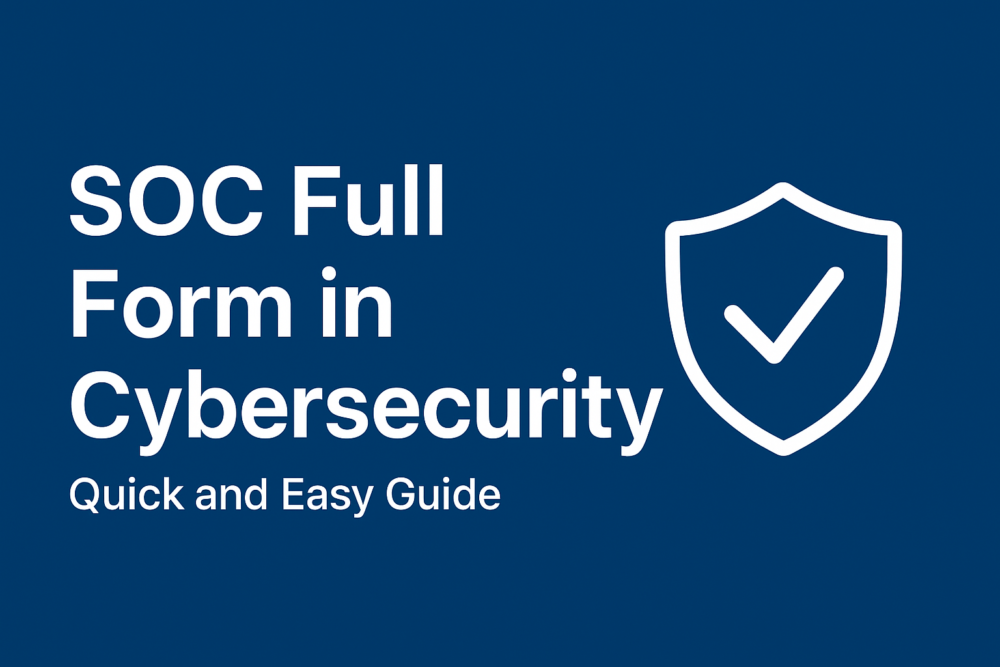
Did you know that 43% of cyberattacks are directed towards small businesses, and more than 60% of these companies go out of business within six months of the attack? With threats like these on the rise, it becomes important to remain well-protected. This is where a Security Operations Center (SOC) comes in. You can think of it as a 24/7 team of experts that keeps watch on your systems, monitors for suspicious activity, and responds to any threats as they arise. This could involve anything from data protection to keeping hackers at bay – the SOC is crucial to the security. So, what actually is the objective of the SOC and why is that so important? Let’s discuss in more detail how it protects your business.
What is a SOC?
SOC full form refers to Security Operations Center (SOC) – a group of professionals acting in unison to safeguard an organization against cyber attacks. They monitor, detect, analyze, and investigate all suspicious activity going on within the company’s system.
They verify things such as networks, servers, devices, operating systems, and databases for any indication of hacking or security breaches. SOC constantly analyzes data, configures security rules, and reacts to new vulnerabilities.
Since modern systems never sleep, a SOC usually works around the clock in shifts to be ready for any threat. Some SOC teams work closely with other departments, while others may get help from third-party security specialists.
Before setting up a SOC, organizations need a solid cybersecurity strategy to guide them. While some companies have their own in-house SOC, others choose to hire a third-party provider to handle it.
Full Form of SOC and Key Functions
The SOC full form in Cyber Security is Security Operations Center, and it has four key tasks:
- Identify – Detect suspicious activity and generate an incident report.
- Investigate – Investigate the cause and effect of the threat.
- Mitigate – Recommend how to eliminate and isolate the threat.
- Continuous Improvement – Continuously update processes and tools to enhance security in real time.
Benefits of a SOC
A SOC offers a number of advantages when properly implemented:
- 24/7 Monitoring – Constantly monitoring for possible threats.
- Faster Responses – Rapid response to any incidents.
- Reduced Downtime – Less downtime recovering from cyber incidents.
- Better Security – Hardware and software control centralized for enhanced protection.
- Collaboration – Enhanced collaboration and communication between departments.
- Cost Savings – Reduced costs in managing security issues.
- Trust – Employees and customers feel more secure sharing their sensitive data.
- Transparency – Gained control over systems and data, which facilitates easier management of legal proceedings if required.
SOC Roles and Responsibilities
The SOC requires a robust team to address emerging cybersecurity threats. The functions of the team members are:
- SOC Manager – Oversees the SOC’s day-to-day operations, develops security policies, and conducts employee training on security best practices.
- Advanced Security Analyst – Searches the system for possible threats and vulnerabilities, examining logs and traffic.
- Incident Responder – Manages security incidents by determining the cause and effect.
- Security Engineer – Designing and installing security systems, such as firewalls, antivirus software, and others.
- Security Investigator – Analyzes incidents by examining data sources to identify root cause.
Challenges for SOCs
Since cybercriminals employ sophisticated tools such as AI and machine learning, legacy security solutions, such as SIEM (Security Information and Event Management), can’t cope.
The volume of data modern systems produce is massive, making it more difficult for SOC analysts to identify threats before it’s too late. Security information from the network, devices, and cloud infrastructure generally resides in individual silos; thus, it is extremely difficult for any SOC team to get a complete picture.
With alert overload, analysts are at risk of missing threats, and it is more difficult to catch attackers in time. This results in “alert fatigue” where analysts get tired of the constant alerts.
The solution to this issue in today’s times is to employ automation, AI, and machine learning to take care of repetitive tasks that are low risk. This leaves SOC analysts free to examine the most serious threats.
Full Forms Related to SOC
Here are some other full forms of SOC used in other industries:
- SOC full form in Cybersecurity: Security Operations Center
- SOC Analyst full form: Security Operations Center Analyst
- SOC full form in Banking: Service Organization Control (A collection of standards employed to quantify how a service organization handles data)
- SOC full form in Medical: System-on-Chip (Utilized in medical equipment and devices)
- SOC full form in Hospital: Standard Operating Procedure (A set of rules used to operate hospital activities smoothly)
- SOC full form in Electronics: System-on-Chip (A chip that combines various components into one, used in electronics)
- SOC full form in Company: System-on-Chip (Used in company products, particularly in technology companies)
- SOC Engineer full form: Security Operations Center Engineer
Conclusion
A SOC (Security Operations Center) is important nowadays to safeguard businesses against cyberattacks. Through identifying, investigating, and preventing threats, a SOC secures business systems. If a SOC has the proper personnel, procedures, and tools in place, then a business will be able to remain ahead of cyber attackers. Through around-the-clock monitoring, rapid response times, or using automation to keep track of regular tasks, a well-executed SOC is most important in maintaining your data safety.
Frequently Asked Questions (FAQs):
Q. What does SOC Analyst mean?
The full form of SOC Analyst is Security Operations Center Analyst, who is tasked with watching over, identifying, and reacting to security breaches.
Q. Is a SOC only for large organizations?
No, although large organizations tend to have in-house SOCs, smaller organizations can also take advantage of SOCs by outsourcing the function to managed security service providers (MSSPs) for cost-effective, expert protection.
Q. What is the full form SOC in Cybersecurity?
In Cybersecurity, SOC is an acronym for Security Operations Center, which is a group of individuals focused on monitoring, detecting, and responding to real-time cybersecurity threats.






